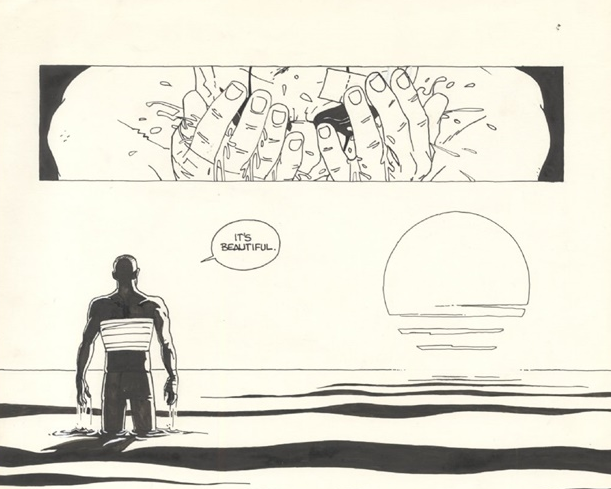Written and Illustrated by Julie Gfrorer
Published by Fantagraphics
When a ship's captain decides that they need to shed a few crew members to survive, two men are set adrift. One of them dies slowly, tempted and tortured by a mermaid in lovely tale of gothic horror for which Gfrorer's style is perfect.
From the opening pages, we see Gforer's dark sense of humor. When one of the sailors asks why they aren't just killed instead of being set adrift, the captain replies that "Now none of us wants to do murder here" --fully aware that his actions are effectively the same, and worse--far more cruel than a bullet to the head. Later on, when the mermaids show up in full force, they ares shown to be cruel and ravenous, with no thoughts for the human they're about to watch die:
They can't even wait for free food!
It's a great bit of characterization, because at first, we aren't sure if the primary mermaid we meet is going to help or harm the sailor. By the time the rest show up, it's clear that she's merely playing with her food. And when we get to the closing moments of the story, where we flash back to land and the sailor's love, the whole thing is absolutely heartbreaking. It's just about perfect in its execution, especially since Gfrorer doesn't over-explain the mystical happenings.
I mentioned above that the style of this comic works very well for its subject matter. As you can see in the image above, there's a very heavy set of lines (I can't imagine how long this took to draw) that evokes the nature of the old etchings found in dime novels, but it's different from, say the way that Rick Geary does a similar effect. I also appreciate how well the mood of the story is expressed in the art. There's a real sense of oppression in the theme and having the extensive lines adds to that. Yet at the same time, Gfrorer doesn't try to overdo the details. Here's another example:
On this page, Gfrorer uses repeated panels with slight changes to set the pace, and while we clearly see we're in the ocean, adrift, on a small boat, and in period-style clothing, there's no need to show every detail on the shirt, or a specific constellation, or lines on the boat or hands. We get enough to show the despair of the sailor, and the arrival of the sign he's prayed for.
Of course, not all signs are positive ones...
I'm not sure if Black is the Color is in print any longer, but it's a great story by a person who gets how to create (and edit--see Mirror Mirror II, for example) horror in a way that really plays with a reader's emotions. If you can find a copy, pick it up. I think you'll get the same shivers I did while reading it.










